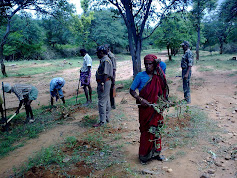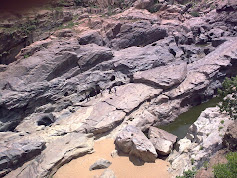

National Rural Employment Guarantee Scheme has just recently been launched since last one month only. Almost 500 mandays are being made in various Gram Panchayats in all the three Ramnagar, Mandya and Chamrajnagar Districts. SC STs and Poorest of the poor and specifically women members are being given emphasis in the rural employement. Habitat Improvement like Tank Desiltation, Lantana Uprootal, Weed Removal around the Water Holes, View Lines and Boundary Consolidation like Elephant Proof Trench repair etc works are being taken up. There is target to produce almost 1000 manday daily. Job Cards have been issued, Bank Accounts have been opened and NMRs are being created for carrying out the physical repair and maintenance of the works of improvement of the habitat of the wild animals in the Kaveri Wild Life Sanctuary.

 Seen from Mutthathi Kaveri in full swing. Flanking Kaveri River both the sides you can see Terminalia arjuana in groups and also Tamarind. I could enjoy black-violet Jamun Fruits of Eugenia Jamboolana trees which are also found in numbers decorated in a line along the river bank.
Seen from Mutthathi Kaveri in full swing. Flanking Kaveri River both the sides you can see Terminalia arjuana in groups and also Tamarind. I could enjoy black-violet Jamun Fruits of Eugenia Jamboolana trees which are also found in numbers decorated in a line along the river bank.


























